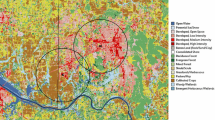Summary
A tethered balloon sounder was used to collect vertical temperature and wind structure data in the Gore River Valley of Western Colorado during December, 1975. Observations taken on a clear morning in which a deep inversion was initially present in the valley showed that the inversion top descended at a steady rate of ∼120 m hr−1. reaching the valley bottom after approximately 4 hours. Weak down-valley winds were present within the inversion layer while stronger up-valley winds prevailed above. A hypothesis is presented to account for these observations. A case study is presented for afternoon and evening cooling in which a ground-based inversion developed to a depth of 175 m in less than 2 hours. Winds within the inversion became decoupled from the synoptic-scale winds and remained very weak during the night. The effect of cloud cover during a morning heating cycle was to make the temperature soundings approach isothermal while sensible heating continued throughout the valley volume.
Zusammenfassung
Im Dezember 1975 wurden durch eine Fesselballonsonde die vertikalen Temperatur- und Windprofile im Gore River Valley im westlichen Colorado ermittelt. Aus Beobachtungen an einem wolkenlosen Morgen bei einer anfangs starken Inversion im Tal zeigte sich, daß die Inversionsobergrenze stetig um 120 m Std−1. absank und nach ungefähr vier Stunden den Talgrund erreichte. Schwache Talabwinde wehten innerhalb der Inversionsschicht. während stärkere Talaufwinde oberhalb derselben herrschten. Eine Hypothese wird vorgeschlagen, um diese Beobachtungen zu erklären. Die Abkühlung am späten Nachmittag und am Abend, wobei die Bildung einer Inversion einsetzte, deren Schichtdicke in weniger als zwei Stunden 175 m betrug, ist Gegenstand einer gesonderten Untersuchung. Winde innerhalb der Inversionsschicht wurden nicht mehr von den Winden in der freien Atmosphäre beeinflußt und blieben im Laufe der Nacht sehr schwach. Bewölkung während der Erwärmungsperiode an einem Morgen hatte zur Folge, daß das Temperaturprofil sich Isothermie näherte, indem Erwärmung gleichmäßig im ganzen Luftraum des Tales sich fortsetzte.
Similar content being viewed by others
References
Ayer, H. S.: On the Dissipation of Drainage Wind Systems in Valleys in Morning Hours. J. Meteor.,18, 560–563 (1961).
Ball, F. K.: Control of Inversion Height by Surface Heating. Quart. J. Roy. Meteor. Soc.,86, 483–494 (1960).
Buettner, K. J. K., and N. Thyer: Valley Winds in the Mount Rainier Area. Arch. Met. Geoph. Biokl., Ser. B,14, 125–147 (1966).
Davidson, B., and P. K. Rao: Preliminary Report on Valley Wind Studies in Vermont, 1957. Final Report. Contract No. AF 19(604)1971, AFCRC-TR-58-29. College of Engineering, New York University, 54 pp. (1958). [Available from N. T. I. S. as PB 138 594.]
Davidson, B., and P. K. Rao: Experimental Studies of the Valley-Plain Wind. Int. J. Air Wat. Poll.,7, 907–923 (1963).
Defant, F.: Local Winds. In. Compendium of Meteorology (Malone, T. M. ed.), pp. 655–672, Boston: Amer. Meteor. Soc., 1951.
Geiger, R.: The Climate Near the Ground. Translated from the 4th German edition. Cambridge: Harvard University Press. 1965.
Hewson, E. W., and G. C. Gill: Meteorological Investigations in Columbia River Valley Near Trail, B. C. U. S. Department of Interior, Bureau of Mines Bulletin,453, 23–228 (1944).
Kuo, H. L.: The Thermal Interaction Between the Atmosphere and the Earth and Propagation of Diurnal Temperature Waves. J. Atmos. Sci.,25, 682–706 (1968).
Machalek, A.: Inversionsuntersuchungen in einem Gebirgstal. Wetter und Leben,26, 157–168 (1974).
Morris, A. L., D. B. Call and R. B. McBeth: A Small Tethered Balloon Sounding System. Bull. Amer. Meteor. Soc.,56, 964–969 (1975).
Scorer, R. S.: Pollution in the Air: Problems, Policies and Priorities. London: Routledge and Kegan Paul, Ltd. 1973.
Stull, R. B.: Inversion Rise Model Based on Penetrative Convection. J. Atmos. Sci.,30, 1092–1099 (1973).
Thompson, A. H.: Surface Temperature Inversions in a Canyon. J. Appl. Meteor.,6, 287–296 (1967).
Tyson, P. D., and R. A. Preston-Whyte: Observations of Regional Topographically-Induced Wind Systems in Natal. J. Appl. Meteor.,11, 643–650 (1972).
Wagner, A.: Theorie und Beobachtung der periodischen Gebirgswinde. Gerlands Beiträge zur Geophysik,52, 408–449 (1938).
Author information
Authors and Affiliations
Additional information
With 6 Figures
Rights and permissions
About this article
Cite this article
Whiteman, C.D., McKee, T.B. Observations of vertical atmospheric structure in a deep mountain valley. Arch. Met. Geoph. Biokl. A. 26, 39–50 (1977). https://doi.org/10.1007/BF02246534
Received:
Issue Date:
DOI: https://doi.org/10.1007/BF02246534




